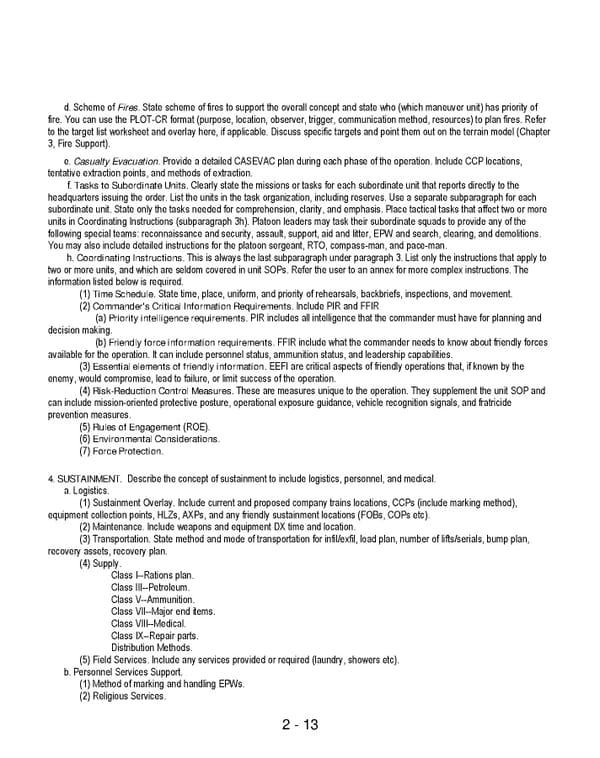2 - 13 d. Scheme of Fires. State scheme of fires to support the overall concept and state who (which maneuver unit) has priority of fire. You can use the PLOT-CR format (purpose, location, observer, trigger, communication method, resources) to plan fires. Refer to the target list worksheet and overlay here, if applicable. Discuss specific targets and point them out on the terrain model (Chapter 3, Fire Support). e. Casualty Evacuation. Provide a detailed CASEVAC plan during each phase of the operation. Include CCP locations, tentative extraction points, and methods of extraction. f. Tasks to Subordinate Units. Clearly state the missions or tasks for each subordinate unit that reports directly to the headquarters issuing the order. List the units in the task organization, including reserves. Use a separate subparagraph for each subordinate unit. State only the tasks needed for comprehension, clarity, and emphasis. Place tactical tasks that affect two or more units in Coordinating Instructions (subparagraph 3h). Platoon leaders may task their subordinate squads to provide any of the following special teams: reconnaissance and security, assault, support, aid and litter, EPW and search, clearing, and demolitions. You may also include detailed instructions for the platoon sergeant, RTO, compass-man, and pace-man. h. Coordinating Instructions. This is always the last subparagraph under paragraph 3. List only the instructions that apply to two or more units, and which are seldom covered in unit SOPs. Refer the user to an annex for more complex instructions. The information listed below is required. (1) Time Schedule. State time, place, uniform, and priority of rehearsals, backbriefs, inspections, and movement. (2) Commander's Critical Information Requirements. Include PIR and FFIR (a) Priority intelligence requirements. PIR includes all intelligence that the commander must have for planning and decision making. (b) Friendly force information requirements. FFIR include what the commander needs to know about friendly forces available for the operation. It can include personnel status, ammunition status, and leadership capabilities. (3) Essential elements of friendly information. EEFI are critical aspects of friendly operations that, if known by the enemy, would compromise, lead to failure, or limit success of the operation. (4) Risk-Reduction Control Measures. These are measures unique to the operation. They supplement the unit SOP and can include mission-oriented protective posture, operational exposure guidance, vehicle recognition signals, and fratricide prevention measures. (5) Rules of Engagement (ROE). (6) Environmental Considerations. (7) Force Protection. 4. SUSTAINMENT. Describe the concept of sustainment to include logistics, personnel, and medical. a. Logistics. (1) Sustainment Overlay. Include current and proposed company trains locations, CCPs (include marking method), equipment collection points, HLZs, AXPs, and any friendly sustainment locations (FOBs, COPs etc). (2) Maintenance. Include weapons and equipment DX time and location. (3) Transportation. State method and mode of transportation for infil/exfil, load plan, number of lifts/serials, bump plan, recovery assets, recovery plan. (4) Supply. Class I--Rations plan. Class III--Petroleum. Class V--Ammunition. Class VII--Major end items. Class VIII--Medical. Class IX--Repair parts. Distribution Methods. (5) Field Services. Include any services provided or required (laundry, showers etc). b. Personnel Services Support. (1) Method of marking and handling EPWs. (2) Religious Services.
 Ranger Handbook Page 34 Page 36
Ranger Handbook Page 34 Page 36